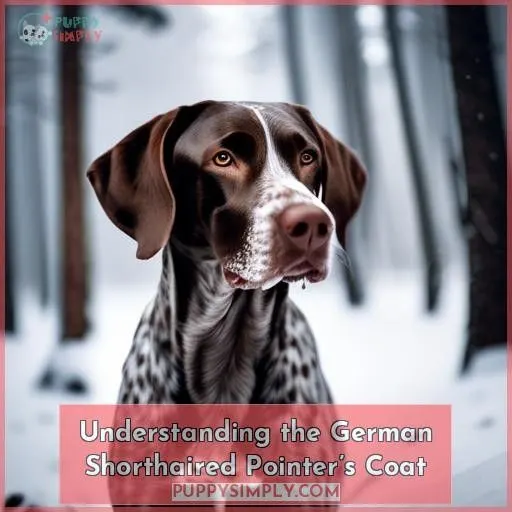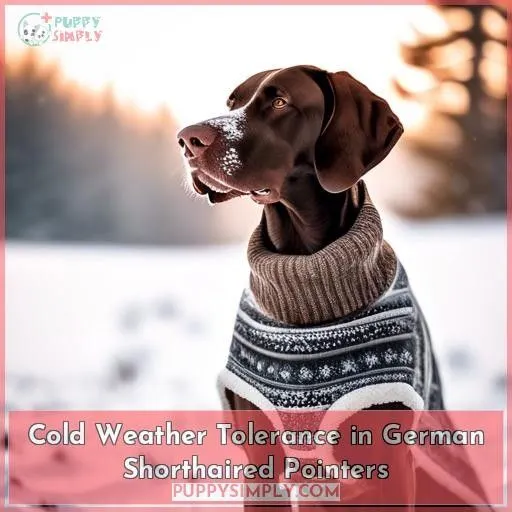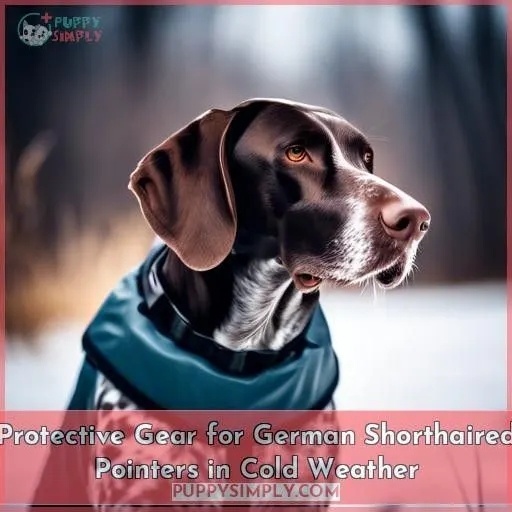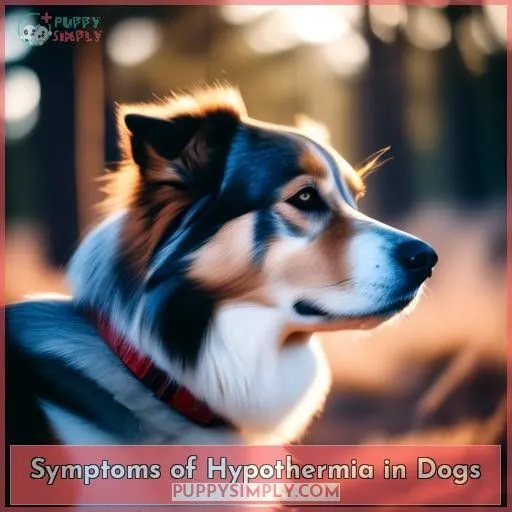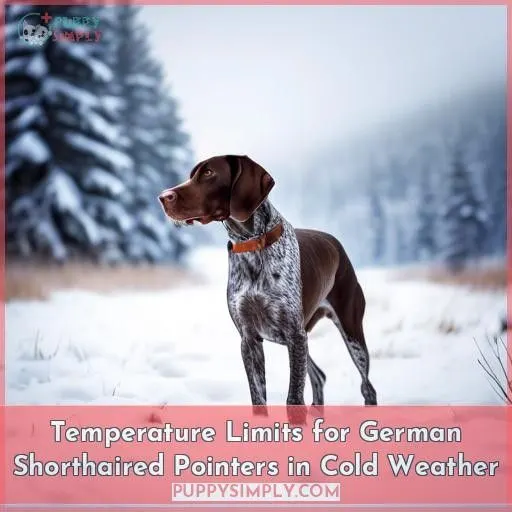This site is supported by our readers. We may earn a commission, at no cost to you, if you purchase through links.
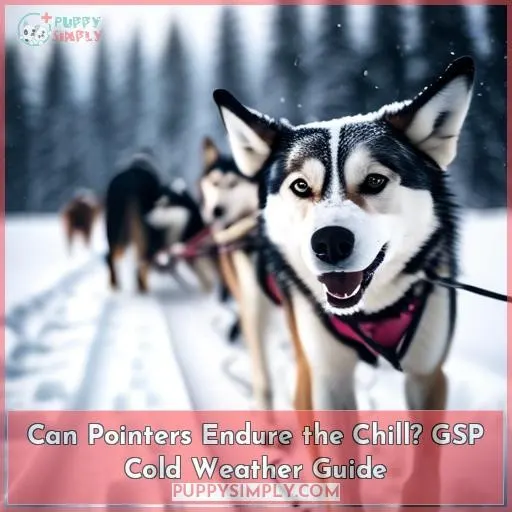
As a German Shorthaired Pointer owner, you may wonder if your pup can withstand the winter chill. The answer depends on various factors. While German Shorthaired Pointers have a short, dense coat that provides some cold protection, they can become uncomfortable in extremely low temperatures.
To keep your pointer comfortable outdoors, you’ll want to provide protective clothing like coats or vests, monitor their activity, and adjust their diet to increase caloric intake. Protecting their paws and ensuring a warm, cozy indoor environment are also essential.
Curious to learn more about keeping your pointer safe and happy during the colder months? Keep reading to dive deeper into cold weather care for these versatile hunting dogs.
Table Of Contents
- Key Takeaways
- Can Pointers Stay Outside in the Cold?
- Understanding the German Shorthaired Pointer’s Coat
- Cold Weather Tolerance in German Shorthaired Pointers
- Protective Gear for German Shorthaired Pointers in Cold Weather
- How Cold is Too Cold: Depends on the Dog
- How Cold is Too Cold: Depends on the Weather
- Symptoms of Hypothermia in Dogs
- Temperature Limits for German Shorthaired Pointers in Cold Weather
- Cold Weather Hunting Practices for German Shorthaired Pointers
- Frequently Asked Questions (FAQs)
- Conclusion
Key Takeaways
- German Shorthaired Pointers (GSPs) should not be left outside in the cold, as their coats do not provide sufficient insulation against very low temperatures.
- In extremely cold weather, GSPs may need protective clothing like coats or vests, and their diets should be adjusted to increase caloric intake.
- Monitoring their activity and providing a warm indoor environment are essential for keeping GSPs comfortable in cold weather.
- GSPs can be sensitive to cold weather, and their tolerance varies based on factors like age, health, and acclimation.
Can Pointers Stay Outside in the Cold?
Yes, pointers can stay outside in the cold. Some breeds, like the German Shorthaired Pointer, have a dense, water-resistant coat that protects them from cold, wind, and rain. These breeds are often happy to join their owners outdoors during colder weather, although they may benefit from extra calories as the temperature drops.
Understanding the German Shorthaired Pointer’s Coat
Grasping the German Shorthaired Pointer’s coat is pivotal for ensuring their comfort and safety in cold weather. These dogs possess a short, dense coat that provides some cold protection but can become uncomfortable in extremely low temperatures.
To maintain your GSP’s comfort in the cold, consider the following:
Provide protective clothing such as coats or vests. This can help insulate your dog and keep them warm in chilly conditions.
Monitor their outdoor activities. Limit the time your GSP spends in very cold weather, and bring them inside if they seem distressed or shivering.
Adjust their dietary requirements. Increase their caloric intake slightly to help them generate more body heat and maintain their weight.
Cold Weather Sensitivity in German Shorthaired Pointers
As a German Shorthaired Pointer owner, you know your dog is built for the outdoors. Their short, dense coat offers some protection, but they may still need a coat or vest for extreme cold. Dietary management is also vital, with a slight increase in calories during winter to maintain body temperature. Regular grooming helps maintain their coat’s insulating properties.
However, like all dogs, they’ve their limits. Understanding your dog’s cold vulnerability is essential for their comfort and safety. Remember, even the toughest pointers need a warm indoor environment and cozy bed sheltered from drafts.
Optimal Living Conditions for German Shorthaired Pointers in Winter
Keep your German Shorthaired Pointer comfortable in cold weather by providing a warm indoor environment and a cozy bed. Protect them with clothing like coats or sweaters. Adjust their diet with a slight increase in calories. Ensure they have regular access to fresh water. Monitor their coat, paws, and skin for dryness or irritation.
Engage in shorter, more frequent walks outdoors. Consider adding supplements to support coat health.
The Importance of Protective Clothing
When the temperature plummets, it’s paramount to safeguard your German Shorthaired Pointer (GSP) from the cold and its adverse effects. Their short, tight coat provides some protection against the cold, but they’re more susceptible to frigid temperatures than breeds with longer or thicker fur. To assist your GSP in withstanding the chill, consider these recommendations:
- Coat materials: Seek out coats constructed from premium, water-resistant materials capable of enduring freezing temperatures. Vests specifically designed for GSPs can offer additional warmth and comfort.
- Vest comfort: Guarantee the vest fits snugly and comfortably on your dog. A proper fit will aid in keeping your GSP warm and dry.
- Paw protection: Safeguard your GSP’s paws with booties or paw ointment to prevent them from cracking or becoming frostbitten in the cold.
- Temperature monitoring: Observe your GSP’s body temperature meticulously, particularly during extremely cold conditions. Indications of hypothermia encompass shivering, lethargy, and pale gums.
- Breed differences: Bear in mind that each GSP is distinctive, and some may possess a thicker coat or more sensitive paws than others.
- Hypothermia prevention: Provide a cozy shelter with a draft-free and well-insulated area for your GSP to rest.
- Outdoor activities: Limit outdoor activities to brief and frequent intervals to prevent your GSP from becoming excessively cold.
- Grooming: Regular grooming is indispensable for maintaining your GSP’s coat’s insulating properties and shielding it from the elements.
Managing Outdoor Activities in Cold Weather
As the temperature descends, it’s imperative to modify your GSP’s outdoor activities accordingly. Cold weather exercise guidelines for GSPs encompass exercising extra caution when retrieving water, ensuring the dog can regain warmth, and being cognizant of temperature boundaries. These boundaries can fluctuate based on the individual dog, the wind chill factor, and whether the dog is wearing protective clothing.
For upland hunting, a personal boundary might be single digits with brief drives and warm-up time between hunts. In extreme cold, contemplate limiting hunting time to an hour or less. Always monitor dogs for symptoms of hypothermia or frostbite and have a strategy in place to warm them up promptly if necessary.
When it comes to cold weather acclimation, GSPs can adapt to colder temperatures, but it may take some time. Puppies, in particular, may need some time to become accustomed to the cold. In milder weather, GSPs can still indulge in outdoor activities, but shielding from the wind is paramount.
Dietary Needs During the Winter Months
Keep your German Shorthaired Pointer (GSP) warm and healthy during the winter months by adjusting their diet. Increase their calorie intake to maintain body temperature, provide fresh water at all times, and consider adding dietary supplements to support coat health. Special treats and a warm dog bed can also help keep your GSP comfortable.
Cold Weather Tolerance in German Shorthaired Pointers
As a conscientious GSP owner, comprehending your pup’s cold weather tolerance is paramount. From shelter necessities and feeding routines to hunting techniques, let’s investigate the essential considerations that can contribute to keeping your German Shorthaired Pointer cozy and secure in the cold.
Factors Affecting Cold Tolerance
Age, health, and acclimation play a vital role in a GSP’s ability to withstand cold weather. Beagles and sled dogs, for example, are better adapted to the cold. However, even if a GSP can stay outside in the cold, leaving them out in the cold without proper shelter or monitoring can lead to hypothermia or frostbite.
Shelter Requirements
Regarding shelter requirements for German Shorthaired Pointers (GSPs) in cold weather, several key factors demand attention. These include draft-free and insulated shelters, raised floors to evade cold ground, sheltered locations out of the wind, and doors or flaps to keep out the cold.
Draft-free and insulated shelters are paramount for maintaining a cozy environment for your GSP. Seek shelters with robust magnetic seals and the ability to withstand strong winds, as these will aid in heat conservation and the maintenance of a warm indoor environment. Insulated kennels or dog houses can also be advantageous, especially if you reside in a colder climate where temperatures drop markedly.
Raised floors are another important consideration, as they help to keep your GSP off the cold ground. This can be achieved by using a raised dog bed or by constructing a simple platform for the shelter.
Sheltered locations are essential for protecting your GSP from the wind, which can dramatically reduce their body temperature. Choose a location that’s shielded from the wind, such as a sheltered dog run or a well-insulated kennel.
Doors or flaps are necessary to keep out the cold and maintain a warm indoor environment. Look for doors with strong magnetic seals and a fuzzy nylon weather stripping lining the edges of the flap, which can provide excellent insulation for the value.
Additionally, consider the age, health, and acclimation of your GSP when choosing a shelter. Older dogs or dogs with health issues may require more insulation or a warmer shelter to maintain their body temperature.
Feeding and Water
Feeding and Water in Cold Weather for German Shorthaired Pointers (GSPs)
Regarding feeding and water in cold weather, consider these essential points for your GSP:
- Boost Calorie Consumption: During cold weather, your GSP may require increased calorie intake to sustain body temperature.
- Accessible Food and Water: Keep food and water readily available for your GSP, as they may need to consume more frequently to maintain warmth.
- Prevent Frozen Water: In extreme cold, water can freeze; therefore, use heated water bowls or change water regularly.
Monitoring the Dog
Monitoring your German Shorthaired Pointer in cold weather is essential to safeguard their well-being. Pay attention for indications of cold stress, such as trembling, sluggishness, or pale gums. If you notice any of these symptoms, take your dog indoors to a warm area and provide them with a cozy bed protected from drafts.
Regularly check on your GSP to make sure they aren’t showing signs of discomfort or hypothermia.
If you plan on hunting with your GSP in cold weather, closely monitor them for any signs of frostbite or hypothermia. Have a plan in place to warm them up promptly if necessary.
Cold Weather Hunting Practices
As a hunting companion, your German Shorthaired Pointer (GSP) is renowned for its versatility and adaptability. However, regarding cold weather conditions, you’ll need to adjust your hunting practices to safeguard your dog’s comfort and safety. Here are four essential considerations:
- Hunting locations: Select locations shielded from wind and cold, such as wooded areas or fields with innate windbreaks.
- Water availability: Make certain water sources are accessible and unfrozen. If necessary, provide water in warmed bowls to prevent freezing.
- Dog temperament and behavior in cold: Observe your dog’s behavior in the cold. If they exhibit signs of discomfort, cold stress, or hesitation to be outdoors, it may be time to bring them indoors.
- Physical activity: Keep hunts brief and provide ample warm-up time between them. Refrain from hunting in damp or snowy conditions if dogs can’t be kept dry.
Protective Gear for German Shorthaired Pointers in Cold Weather
As a German Shorthaired Pointer owner, you’ll want to mull over protective gear to keep your pup comfortable in cold weather. From coats and vests to paw protection and warm transportation, there are a plethora of options to help your GSP withstand the chill.
Coats and Vests
When the cold sets in, it’s time to think about protective gear for your German Shorthaired Pointer. Coats and vests are necessary for keeping them comfortable and tolerant of the cold. Here’s what you need to know about choosing the right coat material, fit, and design for your GSP:
- Coat Material: Look for good-quality materials that provide warmth and comfort without limiting movement. Polartec® polar fleece is a popular choice because it insulates and wicks moisture. Natural wool or microfiber fleece can also be lightweight and warm, while materials like polyester can keep water out.
- Coat Fit: Make sure it fits snugly but comfortably. Measuring your dog’s weight and body measurements will help you choose the right size. Remember, a coat shouldn’t limit movement or stop your dog from doing what they naturally do.
- Vest Design: Think about a vest design that covers the chest and protects the lungs. This is especially important in cold weather, as it helps keep body temperature up and prevents discomfort.
- Paw Protection: While not directly related to coats, it’s necessary to consider paw protection when choosing a coat or vest. Look for options that cover the paws, such as booties or built-in paw protection.
- Cold Tolerance: The coat or vest should help your GSP tolerate the cold, not make it harder. Choose a design that allows for easy movement and doesn’t stop your dog from doing what they naturally do.
Paw Protection
After suiting up, focus on paw protection with durable, waterproof boots and conditioners to keep those paws prime.
- Choosing boots wisely
- Evaluating boot durability
- Ensuring boot waterproofing
Warm Transportation
Warm Transportation: Keep Your GSP Comfortable in Cold Weather
Additional Considerations
When preparing your German Shorthaired Pointer for cold weather, consider their coat type, paw protection, winter grooming, and dietary supplements.
Coat Type
Regarding cold weather, the coat of a German Shorthaired Pointer plays a significant part in their ability to endure the elements. The breed’s coat is short, dense, and engineered for water resistance and quick drying, which can make it challenging to provide adequate insulation in colder climates. However, understanding the limitations of their coat** is essential for providing proper care during the winter months.
The coat genetics of a German Shorthaired Pointer include factors such as fiber density, coat length, fur texture, and coat color. These factors can influence the breed’s cold tolerance and overall comfort in cold weather. For instance, a dog with a thicker undercoat may be better suited to colder climates than one with a thinner coat. Additionally, the breed’s coat color can provide some camouflage in the winter seasons, which can be beneficial in certain environments.
Regarding protective gear, coats and vests can be used to provide an extra layer of warmth and comfort for German Shorthaired Pointers in cold weather. The Rivers West H2P vest is a popular option for its warmth and comfort, while Tuf-foot can toughen paws for protection against cacti and sand burrs. When choosing a coat or vest, consider the dog’s size, weight, age, health, and activity level to guarantee the best fit and effectiveness.
Size
Size is a crucial aspect to take into account when choosing protective gear for German Shorthaired Pointers in frigid weather. Here are four fundamental points to bear in mind:
- Appropriate-sized gear: Verify that the protective gear you select is the right size for your GSP. This will guarantee that the gear fits comfortably and provides the required warmth and protection without hindering movement or causing distress.
- Fit: The gear should be snug but not overly tight. It should enable ease of movement and not restrict the dog’s ability to breathe or carry out its natural functions.
- Insulation: Take into account the insulation qualities of the gear. Thicker insulation may be necessary for smaller dogs, as they’ve a higher surface area-to-volume ratio, which can make them more vulnerable to heat loss.
- Durability: Choose gear that’s robust and can withstand the rigors of outdoor activities in cold weather. This is particularly important for larger dogs, as they may be more active and require gear that can withstand their energy levels.
Weight
When considering protective gear for German Shorthaired Pointers in cold weather, weight is an important factor. Breed comparisons and exercise needs should be taken into account, as well as the limited insulation and wet weather discomfort that may affect their tolerance.
Age, Health, and Activity Level
Age, health, and activity level play a significant role in determining a German Shorthaired Pointer’s (GSP) ability to endure cold weather. Here are three key points to contemplate:
- Age: As dogs age, their ability to regulate body temperature decreases, making them more susceptible to cold weather. Senior GSPs may benefit from additional warmth and protection during cold weather.
- Health: GSPs with underlying health issues, such as hypothyroidism or anemia, may struggle to maintain body temperature in cold weather. It’s essential to monitor their health and adjust their living conditions accordingly.
- Activity Level: GSPs are an energetic breed that generates body heat through exercise. However, their activity level can also affect their ability to endure cold weather. Dogs that are less active may require more warmth and protection from the cold.
To ensure your GSP’s comfort and safety in cold weather, consider the following:
- Shelter: Provide a draft-free and well-insulated shelter that’s large enough for movement and has a raised floor to avoid cold ground. Make sure the shelter is protected from the wind and has a door or flap to keep out the cold.
- Feeding and Water: Increase your GSP’s calorie intake during cold weather to help maintain body temperature. Make sure food and water are available at all times, and consider using heated water bowls to prevent water from freezing.
- Monitoring: Check for signs of cold stress, such as shivering or lethargy, and bring your GSP indoors if necessary. Avoid leaving them unattended outdoors for extended periods in cold weather.
- Hunting Practices: Keep drives short to prevent dogs from getting too cold, provide plenty of warm-up time between hunts, and avoid hunting in damp or snowy conditions if dogs can’t be kept dry.
- Protective Gear: Consider using a coat or vest for added warmth and comfort. The Rivers West H2P vest is recommended, and Tuf-foot can help protect paws from cacti and sand burrs.
How Cold is Too Cold: Depends on the Dog
In cold weather, the tolerance for German Shorthaired Pointers (GSPs) varies by individual dog, age, health, and acclimation factors. While GSPs have a thick double coat for insulation and are active dogs that generate body heat, they can still be affected by cold temperatures. Here are some factors to keep in mind when determining how cold is too cold for your GSP:
- Individual dog tolerance: Each dog has different cold tolerance levels, which can be influenced by factors such as age, health, and acclimation.
- Body condition: Well-conditioned dogs may have better cold tolerance than those with poor body condition.
- Breed variations: Some GSPs may have a lower tolerance for cold weather, especially if they’ve a shorter coat or less body fat.
To keep your GSP safe in cold weather, consider the following tips:
- Shelter requirements: Provide a draft-free, well-insulated shelter that’s large enough for movement and has a raised floor to avoid cold ground. Make sure it’s sheltered from the wind and has a door or flap to keep out the cold.
- Feeding and water: Increase the calorie intake for body temperature maintenance, and make sure food and water are available at all times. Water shouldn’t freeze, and heated water bowls can be used to prevent freezing.
- Monitoring the dog: Check for signs of cold stress, such as shivering, lethargy, or pale gums. Bring the dog indoors if cold stress is observed.
- Cold weather hunting practices: Keep drives short to prevent dogs from getting too cold, provide plenty of warm-up time between hunts, and avoid hunting in damp or snowy conditions if dogs can’t be kept dry.
How Cold is Too Cold: Depends on the Weather
As a German Shorthaired Pointer owner, you’ll need to weigh the weather’s wind chill effect, your dog’s activity level, and the length of outdoor exposure when figuring out how cold is too cold. Factors like these can greatly impact your GSP’s ability to handle chilly temperatures, so it’s critical to observe the conditions and your pup’s comfort level closely.
Wind Chill Factor
Regarding cold weather, the wind chill factor can significantly affect your German Shorthaired Pointer’s comfort and well-being. Wind chill gauges how cold it feels considering the wind, and it can lower the perceived temperature, making it ощущаться гораздо colder than the actual thermometer reading.
Here’s a simple way to grasp the wind chill factor:
| Wind Speed (mph) | Temperature (°F) | Wind Chill (°F) |
|---|---|---|
| 10 | 35 | 22 |
| 20 | 35 | 11 |
| 30 | 35 | 5 |
| 10 | 25 | 16 |
| 20 | 25 | 4 |
| 30 | 25 | minus 2 |
| 10 | 20 | 3 |
| 20 | 20 | minus 10 |
| 30 | 20 | minus 17 |
As you can see, the wind chill factor can make temperatures ощущаться much colder, especially when the wind is strong. This is because the wind can carry away heat from your dog’s body more quickly, leading to a drop in body temperature and possibly causing frostbite or hypothermia.
To safeguard your GSP from the effects of wind chill, consider the following:
- Insulation Materials: Use materials that mimic the insulating properties of fur, such as wool or fleece, to provide an extra layer of warmth.
- Wind Resistance: Look for jackets or coats that are designed to be wind-resistant, as these will help to protect your dog from the cold.
- Shelter: Make sure your dog has a draft-free and well-insulated shelter to protect them from the wind.
- Monitoring: Keep a close watch on your dog for signs of cold stress, such as shivering, lethargy, or pale gums, and bring them indoors if necessary.
Activity Level
Activity level plays a pivotal role in determining how cold is too cold for a German Shorthaired Pointer (GSP) in frigid weather. The dog’s energy expenditure, exercise tolerance, and endurance are critical elements to take into account when evaluating their cold tolerance. Here are four key points to bear in mind:
- Energy expenditure: The more energy a GSP expends during exercise, the more rapidly they’ll generate heat and maintain their body temperature. However, if the exercise is overly strenuous or prolonged, the dog may become fatigued and less capable of enduring the cold.
- Exercise tolerance: GSPs are energetic dogs that generate body heat through physical activity. Nonetheless, their tolerance for cold weather will differ depending on their overall health, fitness level, and acclimation to frigid environments.
- Endurance: Cold weather can adversely affect a GSP’s endurance, as it can impair their ability to maintain body temperature and muscle temperature. This can lead to a decrease in performance and increased risk of hypothermia or frostbite.
- Physical exertion: The intensity and duration of physical exertion can influence a GSP’s ability to withstand cold temperatures. High-intensity activities can generate more heat, but they also increase the risk of overheating or exhaustion, which can lead to a higher susceptibility to cold stress.
Duration of Outdoor Exposure
The length of outdoor exposure is critical for a GSP’s cold tolerance. As the weather turns colder, it’s imperative to watch your dog’s behavior and adjust accordingly. With proper acclimation, training adaptations, and survival strategies, your GSP can endure the chill. Remember, breed comparisons and awareness of behavioral changes can help you make knowledgeable decisions for your dog’s well-being.
Symptoms of Hypothermia in Dogs
You don’t want your beloved GSP to suffer from the dangerous effects of hypothermia. Be vigilant for signs like shivering, lethargy, and pale gums, and act quickly to warm your dog up if you notice these symptoms. Knowing how to properly treat and prevent hypothermia can help keep your GSP safe and healthy in cold weather.
Hypothermia Treatment
Hypothermia is a serious condition that can affect your German Shorthaired Pointer in cold weather. If you notice signs like shivering, lethargy, or pale gums, it’s imperative to act promptly.
Treatment options include gradually warming the dog, providing dry bedding, and seeking emergency care if necessary.
Prevention methods include providing a warm shelter, monitoring outdoor exposure, and keeping your dog active to generate body heat.
Hypothermia Prevention
After addressing hypothermia treatment, let’s delve into prevention, safeguarding your GSP’s comfort. Monitor for hypothermia indicators such as trembling or sluggishness. Here’s your four-step guide:
- Enhance cold weather grooming to maintain their coat in pristine condition.
- Secure paw protection gear for chilly strolls.
- Establish an optimal indoor environment, warm and sheltered.
- Explore dietary supplements to enhance their winter resilience.
Temperature Limits for German Shorthaired Pointers in Cold Weather
Regarding hunting with your German Shorthaired Pointer in cold weather, it’s essential to pay close heed to the temperature limits. While your personal threshold for upland hunting may be in the single digits, you’ll want to refrain from taking your GSP out in temperatures below 10 degrees Fahrenheit for prolonged periods to prevent hypothermia or frostbite.
Personal Limit for Upland Hunting
It’s essential to establish personal limits when hunting with GSPs in cold weather. For most hunters, temperatures below 32 degrees Fahrenheit with short drives and warm-up intervals are manageable. Sunlight and wind conditions should be considered when determining these limits.
However, avoid extended periods in temperatures below 10 degrees Fahrenheit. If temperatures dip below 10 degrees, limit hunting time to an hour or less.
Intact male dogs may have reduced sperm count in cold temperatures.
Avoiding Extremely Low Temperatures
Regarding frigid conditions, German Shorthaired Pointers (GSPs) can tolerate temperatures as low as -20 degrees Fahrenheit. However, individual endurance varies by dog and is influenced by factors like age, health, and acclimatization.
To guarantee their well-being, avoid temperatures below 10 degrees Fahrenheit for prolonged periods. Consider sunlight and wind conditions when establishing temperature limits. If temperatures fall below 10 degrees, limit hunting time to an hour or less.
Intact male dogs may experience a reduced sperm count in cold temperatures.
Monitoring Dogs for Signs of Hypothermia or Frostbite
Monitoring your GSP for signs of hypothermia or frostbite is imperative in cold weather. Stay alert for shivering, listlessness, and pale gums. Should you observe these symptoms, bring your dog indoors promptly. Prevent hypothermia by providing ample shelter, nourishment, and water. Consult a veterinarian for frostbite prevention and timely intervention strategies.
Cold Weather Hunting Practices for German Shorthaired Pointers
When hunting with your German Shorthaired Pointer in cold weather, it’s essential to keep drives brief and provide ample warm-up time between hunts. You’ll also want to avoid damp or snowy conditions and have a plan in place to swiftly warm up your dog if they show signs of being too cold.
Keeping Drives Short
Maintaining short drives is essential when hunting with German Shorthaired Pointers (GSPs) in cold weather. The length of the drive can have a substantial impact on a dog’s ability to conserve body heat and prevent cold stress. To guarantee the safety and well-being of your GSP, follow these guidelines:
- Drive duration: Keep drives brief to avoid dogs from becoming overly chilled. The length of the drive should be determined by the dog’s condition, age, and general health.
- Drive frequency: Space out drives to provide adequate rest and warm-up time between hunts. This will assist your GSP in maintaining its energy levels and body temperature.
- Drive preparation: Ensure that your GSP is well-prepared for the hunting season. Regular exercise and training will assist your dog in developing the endurance required for extended drives in cold weather.
- Drive logistics: Plan your hunting trips carefully, considering weather conditions, wind chill factor, and the availability of shelter and warmth for your dog.
- Drive safety: Continuously monitor your GSP for signs of cold stress, such as shivering, lethargy, or pale gums. If you observe any of these symptoms, immediately bring your dog indoors to prevent hypothermia or frostbite.
Providing Warm-Up Time
- Warm-Up Breaks
- Allow your GSP to take regular breaks during hunting trips to warm up.
- These breaks should be in a warm, sheltered location away from the wind.
- Outdoor Shelters
- Make sure that your dog has access to a draft-free and well-insulated shelter.
- The shelter should be large enough for your dog to move around comfortably.
- Insulation Layers
- Provide your GSP with a coat or vest for added warmth in cold weather.
- Consider using a Rivers West H2P vest, which is designed for warmth and comfort.
- Body Heat Generation
- Encourage your GSP to engage in physical activity to generate body heat.
- Regular exercise can help maintain your dog’s body temperature in cold weather.
- Health Monitoring
- Keep an eye on your GSP for signs of cold stress, such as shivering or lethargy.
- Bring your dog indoors if you notice any signs of cold stress.
Avoiding Damp or Snowy Conditions
When hunting in frigid climes, bear in mind your GSP’s well-being is paramount. Shrewd maneuvers and safeguards guarantee thermal regulation, even as the landscape presents a brisk challenge to your canine comrade.
Having a Plan to Warm Dogs Up Quickly
In cold weather, it’s essential to have a plan in place to warm your German Shorthaired Pointer (GSP) promptly if necessary. Here are three key steps to safeguard your dog’s safety and comfort:
- Emergency shelter: Provide a draft-free and insulated shelter that’s spacious enough for your dog to move around comfortably. Ensure the shelter is elevated off the cold ground and has a door or flap to keep out the cold.
- Vet consultations: If your dog displays signs of hypothermia, such as shivering, lethargy, pale gums, or difficulty walking, seek immediate veterinary attention. Don’t attempt to warm your dog too quickly, as this can cause further harm.
- Body temperature monitoring: Monitor your dog’s body temperature using a digital thermometer. Normal body temperature for dogs is between 101.5°F and 102.5°F. If your dog’s temperature drops below 99°F, it’s a sign of hypothermia, which is an emergency situation.
Additionally, consider using insulation materials like foam sheets or bubble wrap to insulate your dog’s shelter, and provide ample warm bedding materials like straw or blankets to help retain body heat. Always monitor your dog’s health and well-being during cold weather, and consult with your veterinarian if you have any concerns.
Frequently Asked Questions (FAQs)
Can GSPs be left outside in the cold?
You can leave your GSP outside in the cold, but you’ll need to take precautions. Make sure they’ve warm, dry shelter, increased calorie intake, and monitor them closely for signs of cold stress. With the right setup, your GSP can brave the chill.
What are the signs of hypothermia in dogs?
Look out for shivering, lethargy, pale gums – signs your pup’s fighting the cold. Get them inside fast and warm them up gently to prevent dangerous hypothermia. Their safety’s your top priority.
How long can GSPs be left outside in the cold?
You can leave your GSP outdoors in the cold for short periods, but monitor them closely. Aim to limit exposure to under an hour, and bring them inside if you notice shivering or lethargy. Proper shelter and increased calorie intake are musts.
What is the optimal indoor temperature for GSPs?
You’ll want to keep your GSP’s indoor environment around 68-72°F. They’re sensitive to extreme temps, so maintaining a comfy, draft-free space is key for their well-being.
Can GSPs wear coats in cold weather?
A coat helps your GSP stay cozy in chilly temps. Look for ones with good insulation that allow freedom of movement. Just be sure to remove it when inside to avoid overheating your pup.
Conclusion
Coincidentally, if you’ve ever wondered whether pointers can stay outside in the cold, this guide provides the answer.
While German Shorthaired Pointers aren’t immune to chilly conditions, you can help them endure with proper precautions.
Provide insulated gear, monitor activity levels, and adjust their diet accordingly.
By understanding your pointer’s cold tolerance limits and taking preventive measures, you’ll guarantee their safety and comfort during the winter months.

